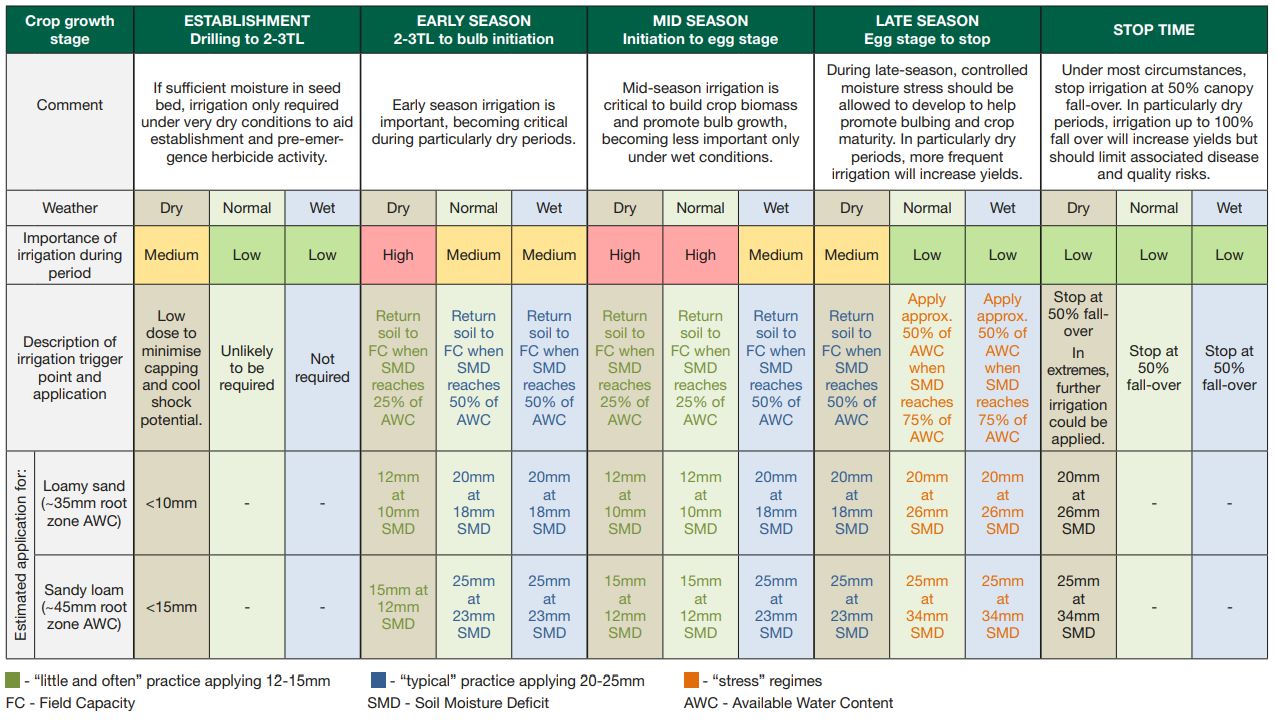Please click here to access the main AHDB website and other sectors.
- Home
- Knowledge library
- Irrigation in bulb onions
Irrigation in bulb onions
This best-practice advice will help you optimise yields and avoid misshapen bulb onions and crops of mixed maturity and size. The impact of irrigation in each phase of the growing season is detailed below. Specific guidance is also offered for growers working on loamy sand and sandy loam soils about when you should - and should not - irrigate to produce a good quality crop.
This information was last updated in 2014.
How does irrigation affect your bulb onion crop?
Correct irrigation helps you to produce consistently sized and disease-free bulb onions. Knowing when to irrigate and, at some points in the growing season, withhold water, is critical for a successful crop because:
- Onions have sparse and shallow roots, and increasingly are grown on free-draining soils in the UK
- Water stress up to the egg stage significantly reduces yields
- Meanwhile, over-watering can trigger basal rot and high levels of latent bacteria.
Planning to acheive successful irrigation of a bulb onion crop
Correct irrigation is crucial for producing consistently sized and disease-free bulb onions.
- Onions have sparse and shallow roots and in the UK are increasingly grown on light, well-draining sandy loam and loamy sand soils.
- This means that irrigation has become an essential part of production for about 85% of the UK crop.
- Water stress up to the egg stage significantly reduces yields; over-watering can trigger basal rot and high levels of latent bacteria.
Discover when you should and should not irrigate to produce good yields and optimise quality by reading the guidance on these pages.
Properly irrigated bulb onions thrive, but it’s all about the timing. Table 1, below, shows exactly when to water bulb onions and when you should stop for the best possible disease-free, consistently sized bulb onion crop.
Table 1. Suggested irrigation regimes for loamy sand and sandy loam soils
The suggested irrigation applications below assume that the root zone for onions is 30cm and that the soil is in good condition to allow effective crop rooting. Excessively loose or slumped/compacted soils will adversely affect crop rooting and therefore the potential crop water uptake.

Bulb onion irrigation: water stress, and why and when to irrigate
Drought-sensitive bulb onions need water. Find out why it matters that they get the right amount of water at the right time, and how early season stress can be particularly damaging to your bulb onion crop.
Bulb onion irrigation: crop establishment and early season
Generally, there is no need to irrigate at drilling time but there are conditions when some watering will help establish the crop and make pre-emergence herbicides more effective. Likewise, during early season growing, it pays to water sparingly and carefully at carefully chosen times.
Bulb onion irrigation: middle season and late season
Irrigation is critical for bulb onions in the middle part of the season, from bulb initiation to egg stage in early August. Towards the end of the growing season, more irrigation may increase bulb size but increases the risk of foliar diseases.
Author
Tim Lacey, Vegetable Consultancy Services (UK) Ltd.
Topics:
Sectors:
Tags:

